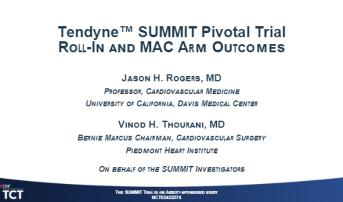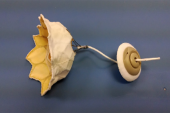SUMMIT: MV Replacement With Tendyne Shows Promise in Severe MR, MAC
Initial experience with the transapically implanted valve was associated with MR elimination and QoL improvements.

Among patients with either severe symptomatic mitral regurgitation (MR) or with severe mitral annular calcification (MAC) who are deemed too high risk for surgery but eligible for MitraClip (Abbott), transcatheter mitral valve replacement (TMVR) with the Tendyne device (Abbott) is associated with good procedural success and promising results over time, according to new SUMMIT trial data.
In the first group—the roll-in cohort representing the initial experience with this procedure at dozens of US sites—the replacement procedure resulted in sustained MR elimination and improved heart failure symptoms and quality of life through 1 year as well as increases in cardiac output and forward stroke volume. For the population with severe MAC, MR elimination at 30 days was associated with improvements in hemodynamics, functional status, and quality of life as well as meaningful changes in cardiac output and forward stroke volume, reduced MV gradient, and reduced heart failure symptoms.
The findings represent a welcome change of pace in the otherwise slow progress of transcatheter mitral valve replacement. While transcatheter edge-to-edge mitral valve repair has made strides for patients with heart failure and severe MR, not all patients have anatomies suited to this procedure. The last large Tendyne study, published in the Journal of the American College of Cardiology in 2021, showed that the procedure may reduce the severity of disease, improve symptoms, and lower the rate of hospitalization for heart failure over 2 years, but that study had a high rate of early patient mortality, prompting questions around patient selection. Prior to that, 1-year findings from the Tendyne Global Feasibility Study were published for the first 30 patients implanted with the device, a trileaflet porcine pericardial valve that is delivered transapically and permanently anchored to the apex with a tether. Encouraging 30-day data in the first 100 patients came in 2018, and the device was granted CE Mark approval in early 2020.
“There are a few centers that will operate on MAC, but the vast majority of patients with MAC in the community are not treated,” said Jason H. Rogers, MD (University of California, Davis Medical Center), who presented the roll-in data last week at TCT 2023, during a press conference. “They are deemed prohibitive surgical risk. And this really does provide an option for that patient population.”
Similarly, Vinod H. Thourani, MD (Piedmont Heart Institute, Atlanta, GA), who presented the MAC data during the same presentation, called the MAC patient one who “is very difficult for us to operate on, especially when you have 30,000 cubic millimeters of calcium. This will fit very well into our armamentarium.”
Speaking during the session, Joanna Chikwe, MD (Cedars-Sinai Medical Center, Los Angeles, CA), said: “What an absolute pleasure to be a mitral surgeon at a meeting where you are presenting a solution for something that we find incredibly challenging.”
SUMMIT Results
For the SUMMIT Tendyne trial, the researchers enrolled patients with symptomatic MR grade III/IV or severe MAC in whom the heart team deemed transcatheter treatment more appropriate than surgery and had anatomy amenable to both Tendyne TMVR and MitraClip.
For the 100 patients included in the roll-in arm who did not have severe MAC (mean age 75.2 years; 54% men), mean LVEF was 48.6%; STS-PROM was 6.5%; and about one-third and two-thirds, respectively, had primary and secondary MR. Technical success was 94%, with the valve implanted successfully in 97% of patients. Procedural major complications were low: three patients required emergency surgery and one patient had a stroke.
We call it a transcatheter procedure, but it's very much a surgical procedure. Jason H. Rogers
All-cause mortality was 11.0% at 30 days and 27.0% at 1 year, with COVID-19 accounting for “several” of these deaths, according to Rogers. Two patients required reintervention by 1 year, both for tether retensioning to optimize valve position. No patients had major device thrombosis by 1 year, but two had minor events incidentally discovered on echocardiography.
Major bleeding was reported in about one-third (32.4%) of patients by 1 year. This was “not unexpected for a new procedure with new sites and new operators,” Rogers said.
At 12 months, the valve had reduced or eliminated mitral regurgitation to either zero or 1+ in 96.5% of patients. There were also significant improvements in NYHA class (80% of patients were classified as class I or II at 1 year compared with 31% at baseline) and Kansas City Cardiomyopathy Questionnaire (KCCQ) score (mean 15-point gain by 1 year). Paired echocardiographic assessments showed favorable remodeling of the left ventricle as well as increases in cardiac output and forward stroke volume.
For the severe MAC cohort, 474 patients were screened, but only 120 were included, with the primary reasons for screening failure being insufficient neo-left ventricular outflow tract (LVOT), annular dimensions outside of treatable range, and interaction with the inner valve frame. Of the 103 ultimately treated (mean age 78.0; 44.7% men), median and maximum MAC volumes were 4,000 mm3 and 38,000 mm3, respectively. In this cohort, 90.3% had primary MR, 89.0% had grade III or IV MR severity, and 10.7% had severe mitral stenosis. Mean STS-PROM in this group was 7.1%.
Here, procedural success was 98% and technical success was 94%. Six patients required emergency procedure intervention, and 2.9% required cardiopulmonary bypass. The primary endpoint for this cohort will be reported 1 year, but at 30 days, 6.8% of patients died, 1.0% had a stroke, and 2.0% needed mitral reintervention. Major bleeding was reported in 21.4%.
MR was completely eliminated, with 98.9% of patients having none/trivial MR and all having MR grade ≤ 1. NYHA classification improved such that 68.6% of patients were considered class I or II by 30 days. While minimal improvements in KCCQ were observed at 1 month, Thourani highlighted that “these were surgical procedures where patients have thoracotomies, and they still need a little bit more time to recover.”
Paired echocardiographic assessments showed slight decreases in LVEF, left ventricular end‐diastolic volume (LVEDV), and mitral valve gradient as well as increases in cardiac output and forward stroke volume. The LVOT gradient “was not very high,” at a mean 2.4 mm Hg at 1 month.
The ‘Achilles’ Heel’
With regard to the high proportion of patients who screened out of the severe MAC cohort, Thourani said neo-LVOT “continues to be a problem,” since some patients weren’t eligible due to too large, but also too small of an annulus.
In the protocol of the clinical trial, Rogers said they were not able to perform any leaflet modification, but European operators have had success with anterior leaflet splitting before a Tendyne procedure. “That has worked and that may help to expand the number of patients that can be treated,” he said. “I think there are probably some adjunctive therapies that can help us to screen pass more, but obviously they are not allowed within the clinical trial.”
Chikwe commented on the mortality rate observed and asked if it was related to the major bleeding. “Is transapical really the Achilles' heel of this procedure? Is this something that could become a transcatheter device?” she asked.
“We call it a transcatheter procedure, but it's very much a surgical procedure,” Rogers said, adding that this valve will not be able to be adapted to either a transfemoral or transeptal approach. “That said, we have seen improvements with site experience. These were the first two cases at these sites.”
Thourani added that operators were required to have some Tendyne experience before being allowed to implant in the MAC arm. “That is why you we saw a lower observed-to-expected ratio compared to the STS score in the MAC arm because there was some familiarity of that team,” he said. “For the roll-in patients, that might have been their first time doing it.”
Session co-moderator David Cohen, MD (St. Francis Hospital, Roslyn, NY), noted that another, less-invasive option for MAC patients is off-label transseptal implantation of the Sapien valve (Edwards Lifesciences). “Do you see these as complementary or you think [Tendyne] is going to take over?” he asked.
The data for this off-label approach with Sapien “hasn't been phenomenal, and there have been a lot of issues with LVOT obstruction that happens,” Thourani explained, adding that his hospital performs “a lot of both,” but the operator has to be ready to perform a LAMPOON procedure. With Tendyne, “you have a little bit more wiggle room,” he said.
“The MAC patient population has the strongest clinical need right now at centers, and that is why that arm enrolled first,” Rogers said. “What is really nice about Tendyne is that . . . it's a very controlled procedure. The Tendyne valve has the largest matrix of sizes because it can be delivered transapically, . . . and it is very predictable. That predictability for me would be an advantage over an off-label use of [Sapien].”
It's also about a feeling of “gestalt” as to whether a patient will tolerate apical access, he added. “In those above the age of 85, we try to stay away from the apical access because most patients don't tend to do as well.”
Cohen agreed. “No, it wasn't a lot of fun when we were doing it for TAVR,” he said. “So it's definitely a challenge.”
Yael L. Maxwell is Senior Medical Journalist for TCTMD and Section Editor of TCTMD's Fellows Forum. She served as the inaugural…
Read Full BioSources
Rogers JH, Thourani VH. Tendyne SUMMIT pivotal trial roll-in and MAC arm outcomes. Presented at: TCT 2023. October 24, 2023. San Francisco, CA.
Disclosures
- The SUMMIT trial is sponsored by Abbott.
- Rogers reports serving as a consultant to Abbott, Boston Scientific, and Laminar and holding equity in Laminar.
- Thourani reports receiving grant/research support from Abbott Vascular, Artivion, Boston Scientific, CroíValve, Edwards Lifesciences, JenaValve, Medtronic, and Trisol; receiving consulting fees/honoraria from Abbott Vascular, Artivion, Boston Scientific, CroíValve, and Edwards Lifesciences; and holding ownership interest in Dasi Simulations.





Comments